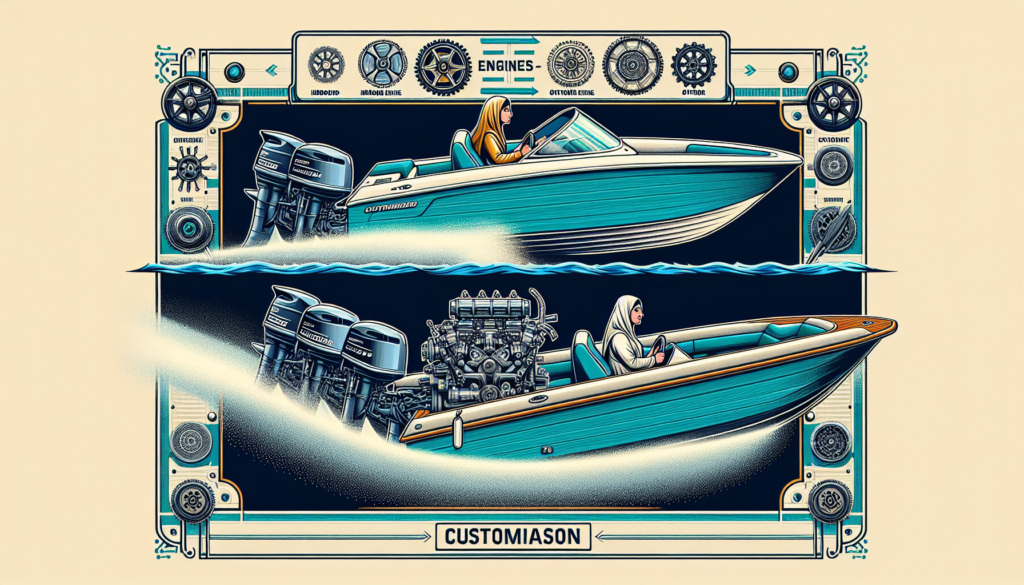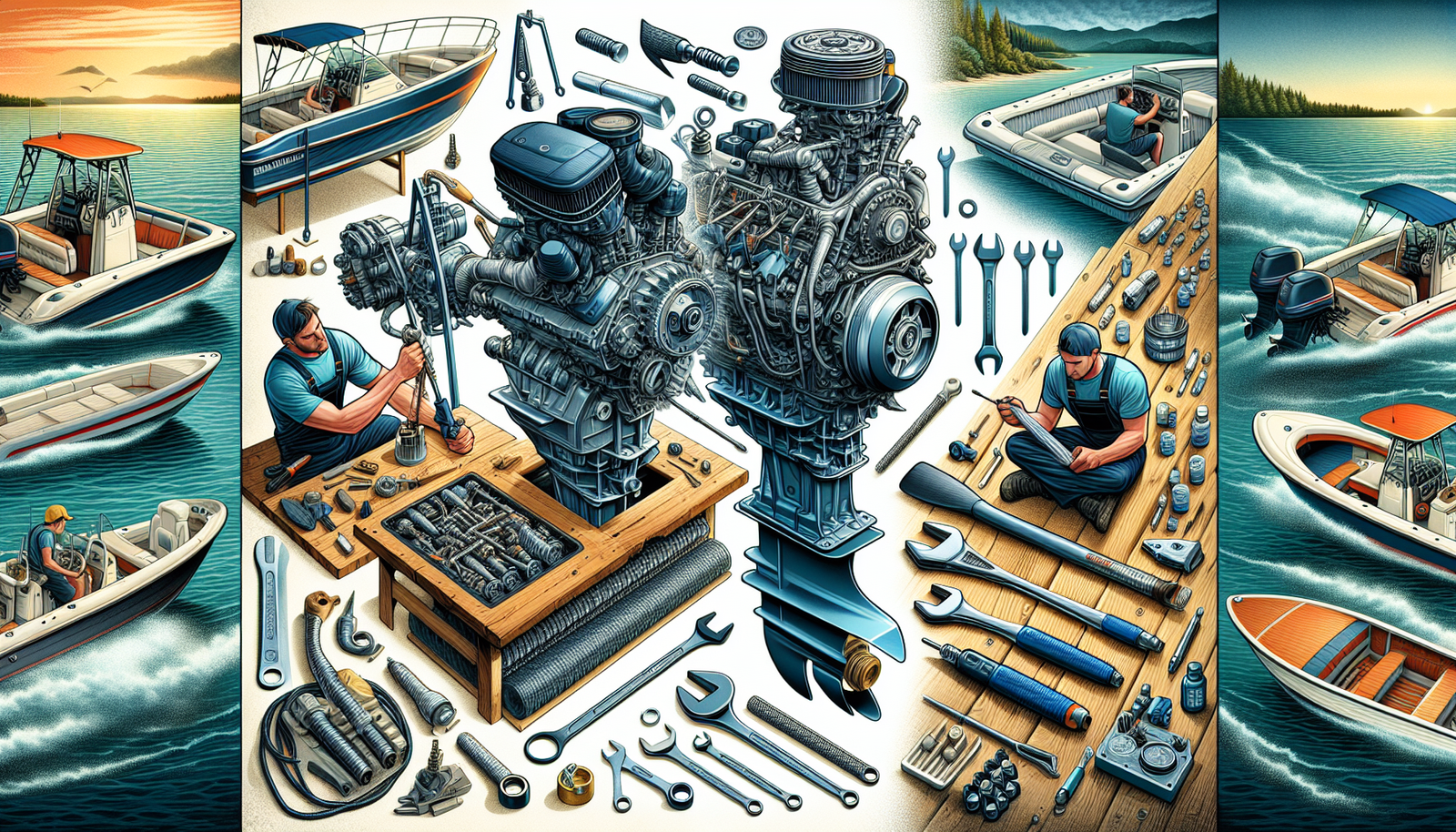Are you a boat owner looking to customize your boat’s engine? If so, it’s important to understand the best practices for customizing inboard vs. outboard boat engines. Each type of engine has its own unique characteristics and considerations when it comes to customization. In this article, we’ll explore the key factors to consider for both inboard and outboard engines, helping you make an informed decision about which customization options are best suited for your boating needs. Whether you’re seeking increased performance, fuel efficiency, or simply aesthetic enhancements, we’ve got you covered with expert advice on customizing inboard vs. outboard boat engines.

Determining Your Needs and Preferences
When customizing your boat engine, it is important to first consider your needs and preferences. Think about the type of boating activities you plan to engage in. Are you fond of fishing, water skiing, or simply cruising? The type of activities will influence your engine choice and customization options.
Next, evaluate the size and design of your boat. Larger boats require more powerful engines, while smaller boats can do well with smaller engines. Additionally, the design of your boat may impact the type of engine that can be installed and customized.
Assessing your requirements for speed and performance is also crucial. If you value high speeds and intense maneuverability, you may prioritize engines that offer such capabilities. On the other hand, if you are more focused on fuel efficiency and maintaining a lower speed, your customization choices may differ.
Finally, factor in the fuel efficiency and maintenance costs associated with the engine models you are considering. A more fuel-efficient engine may save you costs in the long run, while less maintenance-intensive options may appeal to those who prefer minimal upkeep.
Understanding Inboard and Outboard Engines
Inboard engines are typically placed within the hull of the boat, providing a centralized power source. These engines are ideal for larger boats and offer advantages such as improved handling and weight distribution. Outboard engines, on the other hand, are located on the exterior of the boat, providing more flexibility in terms of installation and maintenance.
Advantages of inboard engines include their ability to generate more horsepower, which is beneficial for larger boats and activities that require higher speeds. Inboards also tend to provide improved fuel efficiency due to their higher torque and lower RPMs. Furthermore, inboard engines offer a quieter and smoother ride, as the engine noise and vibrations are isolated within the hull.
Outboard engines, on the other hand, are known for their versatility and ease of maintenance. They can be easily tilted out of the water, making them less prone to corrosion and damage. Outboards also offer simpler installation and accessibility for maintenance tasks, as they are located externally. Additionally, outboard engines tend to have better maneuverability and allow for shallow water navigation.
However, inboard engines also have some disadvantages. They can be more expensive to purchase and install, especially for retrofitting purposes. The necessary space within the hull for an inboard engine can also limit the available interior space of the boat. Inboard engines can also experience issues with cooling and ventilation, requiring additional customization efforts.
Similarly, outboard engines have their own disadvantages. They have a limited range of motion due to their fixed position, which can impact maneuverability in certain situations. Outboards can also be noisier and produce more vibrations compared to inboard engines. Additionally, the overall weight of the boat can be increased with multiple outboard engines, affecting performance and fuel efficiency.

Customizing Inboard Engines
When customizing an inboard engine, several considerations come into play. First, you need to select the appropriate inboard engine for your boat. Consider the power output, torque, and fuel efficiency of the engine options available. Consult with experts and manufacturers to ensure compatibility and optimal performance.
Determining the engine configuration is also important. Choose between direct drive, V-drive, or stern drive setups based on your needs and boat design. Each configuration has its advantages and considerations, such as propeller positioning and hull clearance.
Choosing the right propeller is crucial for maximizing engine performance. Factors to consider include the material, number of blades, and pitch. The correct propeller will ensure efficient propulsion, reducing fuel consumption and increasing overall performance.
Engine cooling and ventilation are critical for preventing overheating and maintaining optimal performance. Customize your boat’s cooling system, ensuring sufficient airflow and proper ventilation. Consider the placement of air intakes, exhaust outlets, and cooling pumps to maintain engine temperature.
To optimize engine room layout and accessibility, plan the arrangement of components and auxiliary equipment. Ensure easy access for routine maintenance tasks and repairs. Consider factors like engine weight distribution, noise insulation, and fire suppression systems.
Installing auxiliary equipment and accessories can enhance the functionality and safety of your boat. Customize your boat with features like generators, air conditioning, water makers, and marine electronics. Decide on the most suitable equipment based on your boating activities and comfort preferences.
Customizing controls and instrumentation provides you with greater flexibility and ease of use. Select control systems that match your boating style, such as throttles, shifters, and steering systems. Install instrumentation that allows you to monitor crucial engine parameters, including temperature, oil pressure, and RPMs.
Integrating electronic systems can greatly enhance your boating experience. Consider installing navigation systems, fish finders, chart plotters, and radar. Electronic systems also enable you to connect and manage other boat functions like lighting, electrical systems, and entertainment devices.
To ensure proper weight distribution, calculate the total weight of your boat and its contents. Distribute the weight evenly to maintain balance and stability. Proper weight distribution will help optimize performance and fuel efficiency while improving handling and maneuverability.
Customizing Outboard Engines
Customizing an outboard engine involves different considerations compared to inboards. When choosing an outboard engine, consider factors such as power output, fuel efficiency, and reliability. Consult with experts and manufacturers to select the most suitable outboard engine for your boat.
Decide on the number of outboard motors based on your boating needs and preferences. Multiple outboard motors can provide greater power and redundancy but may increase the overall weight and cost of the boat. Consider the balance between power, performance, and practicality.
Selecting the correct shaft length is crucial to ensure the outboard motor is properly submerged. Measure the distance from the mounting location to the waterline to determine the optimal shaft length. A mismatched shaft length can result in reduced performance, cavitation issues, and potential damage to the motor.
Optimizing the mounting height of the outboard motor is essential for improving performance and minimizing drag. Adjust the mounting height based on the boat’s design, load, and desired performance characteristics. The correct mounting height will enhance efficiency and reduce fuel consumption.
Consider hydraulic steering options to improve maneuverability and ease of steering. Hydraulic steering systems provide effortless control, especially in larger and more powerful boats. Customize your boat with steering mechanisms that match your needs and preferences.
Installing trim tabs or hydrofoils can further enhance the performance and stability of your boat. Trim tabs allow you to adjust the boat’s attitude in different conditions, improving planing, ride quality, and fuel efficiency. Hydrofoils redirect water flow, reducing drag and improving overall performance.
Customizing fuel and oil systems can optimize performance and reduce fuel consumption. Install high-quality fuel filtration systems and consider the use of electronic fuel injection technology for improved efficiency. Optimize oil systems to ensure proper lubrication and minimize engine wear.
Choosing the appropriate propeller is crucial for optimizing performance and fuel efficiency. Consider factors like material, number of blades, and pitch to match the desired performance characteristics of your boat. A well-matched propeller will enable the outboard motor to operate at its highest potential.
Adjusting trim and tilt settings allows you to fine-tune the outboard motor’s performance based on different operating conditions. Optimize trim and tilt settings to achieve the desired balance between speed, fuel efficiency, and ride quality. Experiment with different settings during sea trials to find the ideal configuration.
Integrating electronic controls enhances the usability and functionality of your outboard engine. Install control systems that match your preferences, such as digital throttle and shift controls. Electronic controls provide smooth operation, precise control, and real-time diagnostics.

Considering Weight Distribution and Balance
Understanding the impact of weight distribution is crucial for customizing your boat for optimal performance. Uneven weight distribution can affect handling, stability, and fuel efficiency. Ensure that the weight is evenly distributed throughout the boat to maintain a balanced and stable ride.
Proper balance is essential for optimal boat performance. Balance refers to the distribution of weight between the bow and stern, as well as port and starboard. Adjust weight distribution, fuel tank placement, and storage to achieve the desired balance. A balanced boat will handle better and be more efficient in its operation.
Consider the effects of the engines’ weight distribution when customizing your boat. Inboard engines are typically located towards the center of the boat, providing better weight distribution. Outboard engines, especially when multiple are installed, can affect weight distribution and require careful consideration.
Optimizing boat performance through weight distribution involves finding the right balance between speed, fuel efficiency, and stability. Experiment with different weight distribution setups during sea trials to determine the optimal configuration for your specific boat and boating activities.
Customize storage and equipment placement to suit your needs and preferences. Consider the placement of heavy items, such as batteries and fuel tanks, to maintain proper weight distribution. Organize equipment and gear to maximize space and accessibility, making your boating experience more enjoyable.
Tuning and Maintenance
Performing regular engine maintenance is essential for ensuring optimal performance and longevity. Establish a maintenance schedule that includes tasks like oil changes, filter replacements, and spark plug inspections. Regular maintenance will help prevent issues and address potential problems early on.
Monitoring and adjusting engine trim is crucial for maintaining optimal performance and fuel efficiency. Trim refers to the angle of the boat’s hull relative to the water. Experiment with different trim settings during sea trials to determine the most efficient configuration for your boat.
Checking propeller condition and performance is important to prevent issues like cavitation, vibration, and reduced performance. Inspect the propeller regularly for damage, corrosion, and signs of wear. Consider professional propeller tuning or replacement if necessary.
Inspecting and cleaning cooling systems is crucial for preventing overheating and maintaining engine performance. Clean the cooling system regularly to remove debris, sediments, and scale that may impede cooling. Inspect hoses, pumps, and heat exchangers for signs of wear and corrosion.
Maintaining and optimizing fuel and oil systems is essential for efficient engine operation. Monitor fuel filters and ensure they are clean and free from clogs. Check oil levels and quality regularly, and follow the manufacturer’s recommendations for oil change intervals.
Monitoring and troubleshooting electrical systems is important for safety and reliability. Regularly inspect wiring, connections, and electrical components for signs of wear, corrosion, or damage. Test electrical systems periodically and address any issues promptly.
Inspecting and maintaining steering systems is crucial for safe and precise boat control. Check steering cables, mechanisms, and hydraulics for wear, leaks, or damage. Lubricate moving parts as per the manufacturer’s recommendations.
Verifying alignment and balancing of the engine components is important for optimal performance and longevity. Periodically check engine alignments and ensure that components are properly balanced. Misalignment or imbalance can cause premature wear and affect overall performance.

Safety and Compliance
Understanding boating regulations and requirements is vital for your safety and compliance while customizing your boat. Familiarize yourself with applicable laws, regulations, and standards regarding boat customization, engine modifications, and equipment installations. Ensure that your customizations meet the necessary requirements.
Ensure proper safety equipment installation to comply with boating safety regulations. Install life jackets, fire extinguishers, distress signals, and other necessary safety equipment as per regulations. Inspect and maintain safety equipment regularly to ensure functionality and effectiveness.
Installing necessary navigation and lighting systems is crucial for safe boating, especially during low visibility conditions. Install navigation lights, GPS systems, and depth finders as required by regulations. Ensure that all lighting systems are in proper working order.
Complying with emission and noise regulations is important to minimize your impact on the environment and avoid potential penalties. When customizing your boat, choose engines and components that comply with emission standards. Consider noise reduction measures, such as mufflers or noise-dampening materials, to meet noise regulations.
Customize safety features and precautions based on your boating activities and requirements. Install additional safety measures like alarms, emergency shut-off switches, or backup systems. Enhanced safety features can provide peace of mind and protect you and your passengers while on the water.
Conducting periodic safety inspections is crucial for identifying potential hazards and addressing safety concerns. Regularly inspect your boat, its systems, and safety equipment for any signs of wear, damage, or malfunction. Address any issues promptly to ensure a safe boating experience.
Seeking Professional Consultation and Support
Engaging with knowledgeable marine professionals can provide valuable guidance and expertise when customizing your boat engine. Consult with professionals who specialize in boat customization, engine modifications, and marine systems. They can provide insights into the best practices and help you make informed decisions.
Consulting manufacturers and experts in the boating industry can help you understand the options and customization possibilities available for your specific boat and engine. Reach out to engine manufacturers, boat designers, and experienced boaters for advice, recommendations, and technical support.
Utilizing professional customization services can ensure that your boat engine customization is performed accurately and safely. Professional services can handle tasks such as engine installation, electrical system upgrades, or performance tuning. They have the expertise, tools, and experience to deliver high-quality customizations.
Obtaining permits and certifications may be necessary, especially for significant engine modifications or retrofitting projects. Check local regulations and requirements regarding engine customization, and obtain any necessary permits or certifications before proceeding with the customization process.
Procuring quality parts and components is essential for reliable and efficient customizations. Choose reputable suppliers and manufacturers when sourcing engine parts, accessories, and additional equipment. Quality parts will ensure proper performance, durability, and compatibility with your customized engine.

Testing and Evaluating Customizations
To ensure that your customizations meet your expectations, conduct sea trials and performance evaluations. These tests allow you to assess the handling, maneuverability, and performance of your customized boat engine in real-world conditions.
Assess the handling and maneuverability of your boat in various situations, such as at different speeds, in rough water, and during turns. Pay attention to how the boat responds to steering commands, accelerates, and maintains stability. Make note of any issues or areas that may require further customization or adjustments.
Monitoring fuel consumption and efficiency is important to evaluate the effectiveness of your customizations. Measure the fuel consumption during different speeds and operating conditions. Compare the fuel efficiency before and after customization to determine the impact of your modifications.
Measuring speed and acceleration allows you to assess the performance improvements achieved through customization. Record the boat’s speed at different RPMs and evaluate the acceleration capabilities. Compare the results with your goals and expectations to evaluate the success of your customizations.
Analyzing overall comfort and user experience is essential for ensuring that your customizations enhance your boating experience. Assess the noise levels, vibrations, and ride quality of your boat. Evaluate if the customizations have improved the overall comfort, safety, and enjoyment while on the water.
Continual Improvement and Modifications
Gathering user feedback and suggestions is valuable for identifying areas for improvement with your customized boat engine. Listen to the experiences and opinions of other boaters who have used similar customizations. Consider their input when planning future modifications or upgrades.
Identify areas for improvement based on your own experiences and observations. Assess any shortcomings or limitations with your customizations. Reflect on the areas where you feel the boat could perform better, and consider modifications that will address these concerns.
Staying updated with new technologies and advancements in the boating industry is crucial for maintaining the competitiveness and efficiency of your customized boat engine. Subscribe to industry publications, attend boat shows, and follow online forums to stay informed about the latest trends and advancements.
Implement necessary modifications and upgrades based on your assessments and the gathered feedback. Address the identified areas for improvement by customizing specific components or systems. Consider technological advancements that can enhance performance, fuel efficiency, and overall boating experience.
Evaluate the impact of modifications by conducting further sea trials and performance evaluations. Compare the results with previous assessments to determine if the modifications have achieved the desired outcomes. Adjust, fine-tune, or expand the customizations as needed to continually improve the performance of your boat engine.

